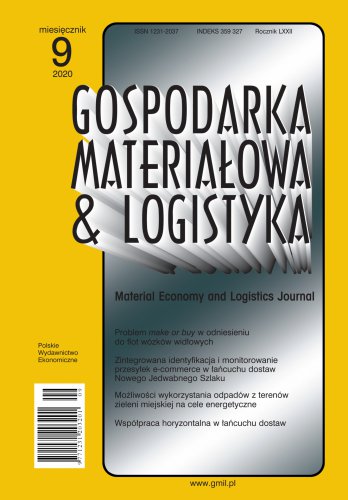Integrated identification and monitoring of e-commerce parcels in the New Silk Road supply chain
Both in the scientific literature and in the observation of business practice, it should be stated that the increase in the share of the e-commerce market on a global scale generates not only business needs, but above all the need to conduct scientific research on improving logistics processes and supply chain information flow. The relatively long delivery time of the ordered goods, the complexity of customs and tax processes make it necessary to closely monitor the status of the realized transport. An additional problem preventing a comprehensive integration of the e-commerce goods supply chain is the different standards required in cross-border shipments in terms of customs or tax. The main aim of this article is to verify the available possibilities of monitoring and identification of goods in e-commerce shipments and the to look for possibilities of process improvements.
References
Bibliografia/References
Baniya, S., Rocha, N., Ruta, M. (2019). Trade Effects of the New Silk Road: A Gravity Analysis. Journal of Development Economics, 146.
Bersenev, A., Chikilevskaya, M., Rusinov, I. (2020). Silk Road Rail Corridors Outlook and Future Perspectives of Development. Procedia Computer Science, 167, 1080–1087.
Dujak, D., Sajter, D. (2019). Blockchain applications in supply chain. W: A. Kawa, A. Martyniak (red.), SMART supply network. Cham: Springer, 21–46. DOI: 10.1007/978-3-319-91668-2
Ejdys, J. (2017). New Silk Road — A Weak or a Strong Signal?, Procedia Engineering, 182, 182–188.
Gerrikagoitia, J. K., Castander, I., Rebón, F., Alzua-Sorzabal, A. (2015). New trends of Intelligent E-Marketing based on Web Mining for e-shops. Procedia-Social and Behavioral Sciences, 175(1), 75–83.
Hu, J., Haddud, A. (2020). Exploring the Impact of Globalization and Technology on Supply Chain Management: A Case of International E-Commerce Business. W: Supply Chain and Logistics Management: Concepts, Methodologies, Tools, and Applications. IGI Global, 1353–1376.
Huang, S. T., Su, I. H., Lee, W. C., Lin, T. H. (2019). Logistics service quality evaluation of cross border e-commerce operators: a multilayer framework analysis in digital shopping market. W: 2019 International Automatic Control Conference (CACS). IEEE, 1–6.
Kawa, A. (2012). SMART logistics chain. W: Asian conference on intelligent information and database systems. Berlin, Heidelberg: Springer, 432–438.
Kawa, A. (2017). Fulfillment service in e-commerce logistics. LogForum 13(4), 429–438.
Kawa, A., Zdrenka, W. (2015). Conception of integrator in cross-border e-commerce. LogForum 12(1), 63–73.
Kayikci, Y. (2019). E-Commerce in Logistics and Supply Chain Management. W: Advanced Methodologies and Technologies in Business Operations and Management. IGI Global, 1015–1026.
Li J., Wen J., Jiang B. (2017). Spatial Spillover Effects of Transport Infrastructure in Chinese New Silk Road Economic Belt. International Journal of e-Navigation and Maritime Economy, 6, 1–8.
Li, F., Su, Y., Xie, J., Zhu, W., & Wang, Y. (2020). The Impact of High-Speed Rail Opening on City Economics along the Silk Road Economic Belt. Sustainability, 12(8), 3176.
Łasak, P. (2018). Rola Polski w ramach chińskiej inicjatywy Nowego Jedwabnego Szlaku, Studia Ekonomiczne. Zeszyty Naukowe Uniwersytetu Ekonomicznego w Katowicach, (372), 182–193.
Maqueira, J. M., Moyano-Fuentes, J., Bruque, S. (2019). Drivers and consequences of an innovative technology assimilation in the supply chain: cloud computing and supply chain integration. International Journal of Production Research, 57(7), 2083–2103.
Mehta, D., Hamke, A. (2019). In-depth: B2B eCommerce 2019. Statista Digital Market Outlook. https://www.statista.com/study/44442/statista-report-b2b-e-commerce/ (31.08.2020).
Śliwczyński, B., Hajdul, M., Golińska, P. (2012). Standards for transport data exchange in the supply chain-pilot studies. W: KES International Symposium on Agent and Multi-Agent Systems: Technologies and Applications. Berlin, Heidelberg: Springer, 586–594.
Śliwczyński, B., Komorowska, M., Statkiewicz, W., Horzela, A. (2019). Nowy Jedwabny Szlak: szansa i wyzwanie dla Poczty Polskiej w obsłudze importu i tranzytu ładunków e-commerce z Chin do Europy. Logistyka, (6), s. 20–27.
Turban, E., Outland, J., King, D., Lee, J. K., Liang, T. P., Turban, D. C. (2018). Intelligent (smart) E-commerce. W: Electronic Commerce 2018. Cham: Springer, 249–283.
Wang, C., Lim, M. K., Zhang, X., Zhao, L., Lee, P. T. W. (2020). Railway and road infrastructure in the Belt and Road Initiative countries: Estimating the impact of transport infrastructure on economic growth. Transportation Research Part A. Policy and Practice, 134, 288–307.
Wang, Y., Jia, F., Schoenherr, T., Gong, Y., Chen, L. (2019). Cross-border e-commerce firms as supply chain integrators: The management of three flows. Industrial Marketing Management, (Sept.).
Zhang, Z. (2008). Weighing stars: Aggregating online product reviews for intelligent e-commerce applications. IEEE Intelligent Systems, 23(5), 42–49.

